This was published 3 months ago
Shae is a librarian. She also plays one of the most brutal sports
Shae Graham’s initial assessment of wheelchair rugby was brutal.
“They are all just trying to kill each other like idiots,” the 37-year-old said, recalling her response almost two decades ago to the documentary Murderball, which follows the US wheelchair rugby team as they prepare for the 2004 Paralympics in Greece.
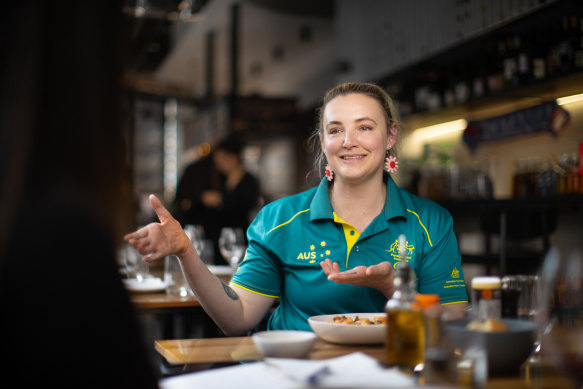
Shae Graham is a librarian by day and a successful wheelchair rugby player by night. Credit: Simon Schluter
Graham was introduced to the film at rehab following a devastating car accident that left the then 18-year-old unable to walk, with a fractured spine and pelvis, brain injury and ruptured bladder.
“I think I’m the only one who went to that movie at rehab who actually plays it now,” she laughs.
We’re having lunch at Rosa’s Canteen, a bright and airy Italian restaurant that overlooks the Supreme Court in Melbourne’s CBD and is popular among legal types. We both love Italian food and the first floor restaurant is accessible by lift so it seems the perfect choice.
Graham is here to talk about her journey to becoming the first female to represent Australia in wheelchair rugby, as well as her preparation for the upcoming Paralympics in Paris. It will be the second Paralympics that Graham has competed in with her beloved Australian Steelers, one of the world’s most successful wheelchair rugby teams.
The menu is unpretentious and pasta-heavy, perfect for an athlete building up her energy stores ahead of elite competition.
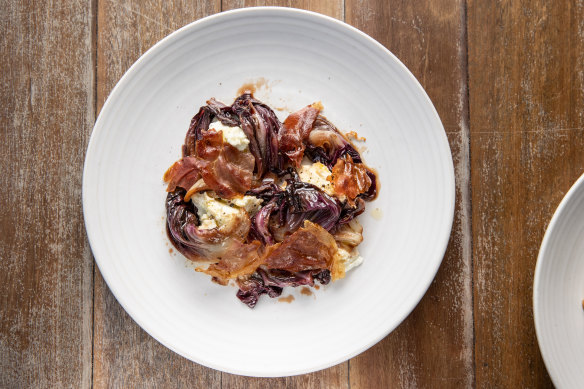
Buffalo mozzarella with roasted radicchio and crispy fioccoCredit: Simon Schluter
We start with two specials from the antipasti section: grilled calamari sitting on a bed of anchovy, orange and delicately sliced fennel and a plate of buffalo mozzarella with roasted radicchio and crispy fiocco, which the waiter describes as similar to prosciutto.
Graham had just finished high school when her life was turned upside down following the crash. The teenager was sitting in the back seat as her friend sped down a residential street in Mackay, northern Queensland, and lost control, smashing into a house. They had been on their way home from a Blockbuster store, armed with rental DVDs in preparation for a quiet night at home.
“I remember walking into the video store, and then I don’t remember anything,” she said. “My gap year was just spent in the hospital instead of travelling.”
Graham spent nine months in hospital and rehabilitation.
“I took a long time to accept it,” she said of her injuries. “I had to grieve a loss. I reached out to a psychologist and also decided that I wasn’t going to let anything hold me back.”
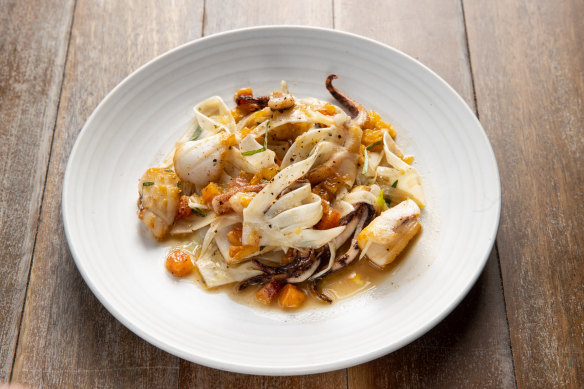
Grilled calamari with fennel and orangeCredit: Simon Schluter
Sport played a big role in Graham’s life prior to the accident. Throughout school, she was heavily involved in athletics, Rugby Union, soccer and touch football. Cathy Freeman, undoubtedly Mackay’s most famous resident, had left a big impression on Graham.
She was also a fast runner and raced in the baking sun at Cathy Freeman Oval, a local sporting facility that had been named in honour of the Olympic champion.
“I grew up wanting to be Cathy Freeman,” she said, eyeing off the plate of rigatoni with pancetta, silverbeet with tomato and ricotta salata that the waiter has placed on the table in front of her.
I’ve ordered the homemade tagliatelle with a succulent wild rabbit ragù that isn’t overpowered by tomato. We’re sharing a side of Brussels sprouts with paprika, garlic and butter, and mopping up all the juice with thick slices of crusty sourdough.
While Graham regained her independence, moving to Melbourne in 2012 to access NeuroMoves, an innovative exercise and therapy service for people with a neurological condition or physical disability, she was reluctant to return to sport.
“I decided that the spinal cord injury was a sign that I should retire from all sport,” she said. “I was trying to protect myself from losing something else. I didn’t think sport would be the same or as good.”
‘When I popped in my first [wheelchair rugby] chair, I just fell in love with the sport instantly.’
Shae Graham
But losing a friendly bet with her brother in 2013 changed all that. “We were travelling around Europe together and fighting over a stupid fact,” Graham recalled.
The siblings agreed that if Graham was right, her brother would have to lug her bags for the remainder of their holiday. If Graham was wrong, she would sign up to a sport chosen by her brother: wheelchair rugby.
“When I popped in my first [wheelchair rugby] chair, I just fell in love with the sport instantly,” she said, tucking into her rigatoni. “It’s a very addictive sport. It’s highly strategic, fast-paced, fun and challenging.”
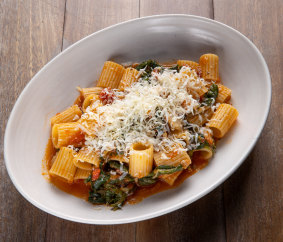
Rigatoni with pancetta.Credit: Simon Schluter
While Graham loves the challenge of wheelchair rugby, it’s the community that surrounds the sport that she enjoys the most.
“Even in other able-bodied sports that I played pre-accident, I don’t think I have ever been part of a community like this ... you’ll meet someone one year, and you’ll still know them many years later. There’s not many people who start playing wheelchair rugby and stop.”
Despite its name, wheelchair rugby is not similar to other forms of rugby, according to Graham.
This is a relief to me, as I’m an AFL-supporting Victorian who can’t tell the difference between rugby union and league.
Originally called “Murderball” due to its combative nature, wheelchair rugby was created in 1976 by a group of Canadian athletes with quadriplegia who were searching for an alternative to wheelchair basketball. They were frustrated at being assigned minor roles in basketball because they did not have enough function to excel at dribbling and shooting hoops, they wanted a sport where they could participate equally, Graham explains.
“It has like elements of basketball, ice hockey, NFL and even AFL,” she said. “The way we start the game, the ball gets thrown up like in AFL, and you’ve got to win possession. It’s got elements of all these different things. They have morphed into this beautiful, unique, weird, full-contact, high-intensity sport.”
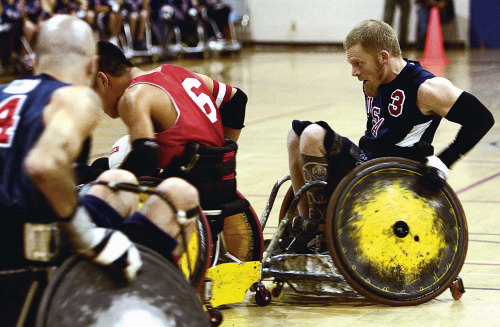
USA team member Mark Zupan (right) playing against Canada in a scene from the documentary Murderball.Credit: Hopscotch Films
It’s common to see the gnarly wheelchairs with steel pick bars crashing into each other, and athletes hitting the floor during the action-packed game. The objective is to cross the opponent’s goal line, clutching a textured volleyball, for a point.
To be eligible to compete, athletes must have a significant impairment that impacts their legs and arms. In 2019, Graham made history when she had her international debut with the Australian Steelers at the Four Nations tournament in the US. She became the first woman to represent Australia in wheelchair rugby at a major contest on the world stage.
“That was pretty cool,” she said. “I didn’t know that was going to happen.”
Graham is currently training with the Steelers five days a week at The Hangar at Tullamarine in Melbourne’s north, which is home to Essendon Football Club and also Paralympics Australia’s Victorian headquarters.
It’s a gruelling training regime, and the bruises on her arms and callouses on her hands from pushing her wheels illustrate the intensity.
The 12-player team, which finished fourth in the Tokyo games and then won the World Championship in Denmark in 2022, has its eyes firmly on gold.
She juggles this with her part-time job as a library officer at the Melbourne Museum, where she catalogues and cares for the institution’s rare book collection, updates collection records and helps with loans and returns.
Graham, who has degrees in arts, marketing, public relations and a masters in information management, also picks up casual weekend shifts at Wyndham library.
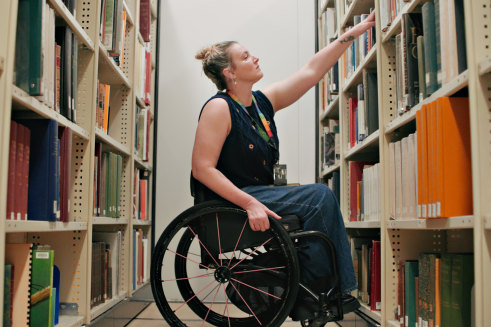
Shae Graham working as a library officer at the Melbourne Museum.Credit: Documentary: Forged In Steel.
“It’s fun to work in a specialist library, like a museum, but also a public library. They’re very chaotic and fun,” she says, as we both help ourselves to a few more Brussels sprouts. Graham is also an avid reader and dreams of opening a bookshop. How does she find time to read with such a busy schedule?
“I try to always read before I go to bed,” she said. “I read until I am about to fall asleep. It relaxes me and lulls me into sleep.”
She’s also extremely disciplined when it comes to her mobile phone use. “I sometimes leave it in the car,” she said. “Everyone says, ‘don’t look at your phone before you go to sleep’. I actually do that by setting my alarm and then grabbing my book.”
Our bowls of pasta are almost empty, and the lunch crowds are retreating to their offices and court. It’s an unseasonably warm winter’s day, and we’re almost tempted to order the homemade gelato or cannoli, an Italian pastry filled with sweetened ricotta that restaurant co-owner Rosa Mitchell ate as a child in Sicily. But we end up declining dessert, saying we are too full.
On Wednesday Graham and the rest of the Steelers team will board a plane to Paris ahead of their first game on August 29 against Great Britain. They’ve been studying their opponents strengths and weaknesses ahead of the big game.
“We know who’s in our pool, and we know who we’re playing,” Graham warns. “We know how they play and what we should expect.”
Graham has a secret strength that not too many people know about. She’s perfected the art of sleeping on a plane. “As soon as the plane starts moving, I am out,” she said.
The librarian and athlete has a trick. “I always put on the Harry Potter audiobooks and Stephen Fry reads to me,” she said. “Because I’ve read and listened to them so many times, it doesn’t matter what’s happening in the story, it’ll just soothe me to sleep.”
Forged In Steel, a documentary that takes a behind-the-scenes look at the Australian Steelers Wheelchair Rugby Team as they fight for their Paralympic dreams, will air on Monday, August 19, at 8.40pm on Channel 9 and 9Now.